Brilliant victory of the Russian army in the war with Turkey 1768 — 1774
Russian-Turkish war of 1768 — 1774's
The Kyuchuk-Kaynardzhi peace treaty was the outcome of the war between Russia and the Ottoman Empire. This war was a consequence of the European big game - the confrontation of the alliance of the northern states (Russia, Prussia, Denmark, Sweden and Poland) with the support of England and France and Austria. One of the fronts of this war passed through Poland. After the death of the Polish king August III in 1763, Stanislav Poniatowski was raised to the throne with the support of Russia. However, against him and the Russian troops entered the Bar Confederation, which focused on Austria and France.
The Confederates, with the support of France, turned to the Ottoman Empire for help. The bribes of the Poles to the Ottoman dignitaries, the concession of Volyn and Podolia, if Turkey sided with the Bar Confederation and the pressure of France, led to the fact that Istanbul agreed to join against Russia. Port considered that it was a good time to restore a number of lost positions in the Northern Black Sea region.
The reason for the war was the border incident in the village of Balta (modern Odessa region). During the military operations against the Bar Confederation, a detachment of Koli (Orthodox rebels in the Western Russian lands who fought against the Polish yoke), pursuing the Confederates, entered Balta, which was then part of the Ottoman Empire. At the local level, the conflict was quickly resolved; there were quite a few similar border incidents at that time. However, it was this incident in Istanbul that they decided to use as a pretext for war. The Russian ambassador, Alexei Obreskova, was thrown into the seven-tower castle.
Porta accused Russia of violating previous agreements. So, before Russia promised not to interfere in the affairs of the Commonwealth and not to introduce its troops into the Polish lands. Russia was also accused of building frontier fortresses directed against Turkey, ruining Balta and building an “unworthy” person on the Polish throne. 25 September 1768 of the year Sultan Mustafa III declared war on the Russian state. Autumn and winter were spent in preparation for war.
The Ottoman command planned to put 600-thousand. army for war with Russia. The main forces of the army were to pass from the Danube to Poland and unite with the Polish Confederates. Then the Polish-Turkish troops were to move to Kiev and Smolensk. The enemies of Russia hoped to restore Rzeczpospolita within the 17th century, creating a powerful buffer state between Europe and Russia. The second Turkish army set its sights on Azov and Taganrog, here the Crimean Tatars were supposed to support it, and the Ottoman fleet from the sea. In addition, part of the forces allocated to suppress the uprising of Christians in Montenegro and Herzegovina. Thus, the plans of the enemies of Russia were very ambitious. The hands of Turkey, the West hoped to squeeze out the Russians from Poland and the Azov-Black Sea region, and even capture Kiev and Smolensk.
The Russian Empire fielded three armies. The 1 Army under the command of Golitsyn (80 Thousands of Soldiers) was to concentrate in the area of Kiev and conduct offensive operations against the main forces of the enemy. The 2 Army under the command of the Governor-General of Little Russia Rumyantsev (40 thousand bayonets and sabers) gathered at Bakhmut and received the task of defending the southern borders of Russia. 3-I army under the leadership of Olic (15 thousand people) gathered at Brod and performed a supporting role.
1769 year. The actual fighting was opened at the beginning of 1769. 10-thousand Turkish-Tatar corps invaded from the Crimea to Little Russia. However, Rumyantsev repelled this strike and sent the punitive detachment to the Crimea, and also strengthened the garrisons of Azov and Taganrog. By the summer of Rumyantsev turned his main forces to Elizavetgrad, but could not continue to attack, as the troops gathered slowly, and he had only 30 thousand people (including 10 thousand poorly armed Cossacks). While on the Dniester stood the Crimean Khan with 100-thousand. the Turkish-Tatar army and 30 thousand Crimean Tatars were threatened with a new blow from Perekop. But, spreading rumors about the movement of a strong Russian army in Podolia, Rumyantsev changed the situation in their favor. Rumors about the offensive of the army of Rumyantsev confused the calculations of the Ottoman command, which had abandoned the initial plan of the offensive. The center of hostilities shifted to the Dniester.
Initially, in the Danube fighting was sluggish. Moldova rebelled against Porta, its lord fled. The Archbishop of Jassi asked Moldova to accept Russian citizenship. But, 45-th. Golitsyn's army (it was not possible to bring the planned number of the army), instead of immediately occupying Iasi, moved on Khotyn. He could not take a strong fortress, losing time and feeling the lack of provisions, the prince took the troops across the Dniester. As a result, the strategic initiative was lost, and the Ottomans were allowed to crush the rebellion in Bessarabia.
The Turks also showed no initiative. Grand Vizier with 200-thousand army forced the Danube and moved to Bessarabia. The Turkish-Tatar troops stayed aimlessly on Prut for a whole month until the middle of June. The Ottoman command offered the Poles to launch an offensive together in Poland. But, the Poles, not wanting to see the hordes of Ottomans and Tatars in their lands, offered the Turkish army to oppose Rumyantsev in Novorossia. Having sent against Golitsyn barrier.
The Vizier accepted this plan. Hotin was sent to 60-th. Auxiliary army, and the main forces were going to strike at Elizavetgrad. But, this campaign failed. Rumors of a strong army of Rumyantsev embarrassed the Ottomans, and the vizier did not dare to force the Dniester, returning back to the Prut in the Ryabaya Tomb tract. To strengthen Khotin, the Vizier sent Moldavanchi Pasha to his seraskira.
Golitsyn again decided to move to Hotin. It was a dangerous maneuver. Golitsyn was removed from the army of Rumyantsev and could not help her. If a more decisive and enterprising commander were in place of the Vizier, then a huge Turkish Ami could strike Kiev and try to defeat Rumyantsev’s army. 24 June Golitsyn crossed the Dniester, near the village of Pashkivtsi overturned the Turkish-Tatar army and blocked Khotin. But, the arrival of the Moldavanchi seraskira army and the Crimean khan Devlet-Girey made Golitsyn lift the siege and retreat beyond the Dniester. It must be said that Golitsyn was a fan of the school of maneuver warfare, which believed that the war was the main maneuver, and not a decisive battle. Therefore, Golitsyn believed that his task was completed - he had distracted the enemy from Novorossia.
The vizier’s lack of initiative and theft (he stole the 25 million piastres allocated to supply the army) forced the sultan to change it to Moldavancha Pasha. The new commander-in-chief received an order to force the Dniester and occupy Podolia. However, the Turkish offensive ended in failure. In late August, 80-th. Turkish-Tatar army crossed the river, but was dropped by Golitsyn troops in the Dniester. And 12-thousand the Turkish detachment, which 5 of September was sent beyond the Dniester for foraging, was completely destroyed by the Russian troops.
Defeats, lack of food and fodder, the theft of command completely demoralized the Turkish army. Almost all the army ran home. Moldovanschi Pasha in Iasi almost killed their own, he barely escaped. Ryaba Tomb remains with only about 5 thousand soldiers, the rest deserted. There remained only a strong garrison in Bendery, small detachments in the Danube fortresses and the Crimean Tatar horde in Kaushany. Devlet Giray soon also disbanded his troops.
But, the Russian command did not take advantage of the complete collapse of the Ottoman army. Golitsyn took Khotyn only without a fight - 163 guns became Russian trophies. However, soon again (for the third time) retreated beyond the Dniester. Catherine II, dissatisfied with such passivity, replaced Golitsyn with Rumyantsev. 2-th Russian army led by Peter Panin.
Rumyantsev, given that the main forces of the Ottomans had gone beyond the Danube, confederate troops did not pose a threat, and the approach of winter, postponed the resumption of hostilities until the spring of next year. The main Russian forces were located between the Dniester, Bug and Zbruch. 17-thousand the avant-garde (Moldavian corps) under the command of General Shtofeln was pushed beyond the Dniester and Prut into Moldavia. Shtofeln was also entrusted with the management of Moldova. Rumyantsev led the troops in order. The regiments were joined in brigades, and brigades in a division. The control of artillery was decentralized - artillery companies transferred to the divisions. In winter, exercises were conducted, special attention was paid to horse attacks and speed of movement.
The avant-garde of Shtofeln in November captured the whole of Moldova to Galati and most of Wallachia, captured two rulers. The fighting continued throughout the winter. Turkish-Tatar troops. Taking advantage of the small number of the Moldavian corps and the dispersion of its forces, Russian advanced forces tried to smash. However, there were bits everywhere. The enemy was defeated at Focsani, at Jurgi and at Bucharest. Russian troops took Brailov.
2-I Russian army unsuccessfully tried to attack the Crimea, but the campaign failed (due to drought). The siege of Bender failed. And because of the absence of siege artillery, the idea of sieging the fortress had to be abandoned. Russian troops in the Caucasus direction operated successfully. Detachments of General Medem and Totleben forced Kabardians and residents of the upper reaches of the Kuban to recognize the Russian authorities.
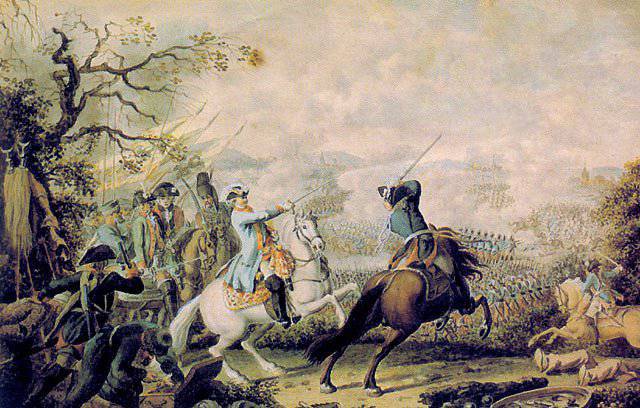
D. Chodovetsky. "Battle of Kagul"
1770 year. The collapse of the army and the successes of the Russian troops had a demoralizing effect on the Ottomans and especially their allies, the Crimean Tatars. However, the Ottoman Sultan was not going to retreat. Disregarding costs, he formed a new army. Crimean Khan Devlet-Giray, who showed no zeal in this war, was replaced by Kaplan-Giray. The Tatars had to prepare for the march from Causen to Iasi, in order to defeat the Moldavian corps until the approach of the main Russian forces and to seize Moldavia and Wallachia.
The Russian war plan was compiled by Rumyantsev, who obtained the sovereign non-interference of St. Petersburg at his disposal. He considered his main task the destruction of the main enemy forces. The 1st Army was to attack the enemy and prevent the Ottomans from crossing the Danube. The 2nd Army received the task of defending Little Russia and taking Bender. The 3rd Army was disbanded; it became part of the 1st Army. In addition, the Russian squadron under the command of Orlov was supposed to support the Greek uprising in the Sea and the Archipelago in the Mediterranean Sea and threaten Constantinople by linking Turkish forces fleet. Shtofeln was ordered to clear Wallachia and concentrate forces for the defense of Eastern Moldova, before the approach of the main forces.
Rumyantsev, having received news of the impending enemy offensive and the critical situation of the Moldavian Corps, spoke before the completion of the army staffing. The Russian commander had 32 thousand people - 10 infantry and 4 cavalry brigades. The brigades were divided into three divisions under the command of Olic, Plemyannikov, and Bruce. The plague that was raging in Moldavia forced Rumyantsev to stay in Northern Moldavia.
But, the deterioration of the situation - a significant part of the Moldavian corps and Shtofeln himself died from the plague, forcing Rumyantsev to continue the offensive. Prince Repnin headed the remnants of the Russian avant-garde on the Prut at Ryaba Mohyla and from 20 May beat off 70-thousand. hordes of Kaplan-Girey. On the night of June 17, Rumyantsev bypassing the maneuver was forced to retreat by the superior forces of the Turkish-Tatar army. 24 — 26 June, the Russian squadron under the command of Orlov and Spiridov destroyed the Ottoman fleet in the Chesme battle.
Rumyantsev did not wait for the army of the Crimean Khan to unite with the army of the Vizier. 7 (18) July 1770, the army of Rumyantsev defeated 80-th. Turkish-Tatar army under the command of Kaplan-Girey in the Battle of Larga. Smaller in number, but superior to the enemy in morale, organization and skill, the Russian army utterly defeated the enemy. The enemy fled in panic. Russian trophies are 33 guns.
July 21 (August 1) 1770 of the Year Rumyantsev defeated the Vizier on the river Kagul. The Moldavanchi Vizier had 150-thousand under his command. army, including 50-th. selected infantry, with 350 guns, and planned to crush Russian troops. Rumyantsev had 17 thousand people under arms. Russian commander ahead of the enemy and he hit the Turkish-Tatar hordes. Russian army three divisional squares knocked over the entire enemy horde. The Vizier and the Crimean Khan fled, 200 guns were captured. Only the Janissaries valiantly counterattacked the division of General Plemyannikov, and nearly had to break the outcome of the battle. But Rumyantsev personally rushed into the battle and saved the situation with a shout of “stop, guys!” The defeat of the brave janissaries ended this decisive battle. After the victory, the Russian troops pursued the enemy and, on the crossing over the Danube and near Kartal, finished off the frustrated enemy army. The remaining Turkish artillery park - 150 guns was captured, taken by Ishmael. Moldavians, after crossing the Danube, were able to assemble only 10 thousand soldiers. The rest fled.
The 1770 campaign of the year ended with a complete victory for the Russian armed forces. If Rumyantsev had reserves, it was possible to force the Danube and put a winning point in the war, forcing the Sultan to capitulate. However, Rumyantsev had only one wartime division, and the plague raged beyond the Danube. Therefore, the commander confined himself to strengthening the position in the Danube principalities and taking enemy fortresses. In August they took Kilya, in early November - Brailov. On this campaign ended.
2-I Russian army also fought successfully. September 16 after a brutal assault Russian troops took Bender. From 18-th. 5 thousand people died in the Turkish garrison, another 11 thousand were captured, the rest fled. Russian troops have lost 2,5 thousand people killed and wounded. The fortress captured 348 guns. Soon captured and Akkerman.
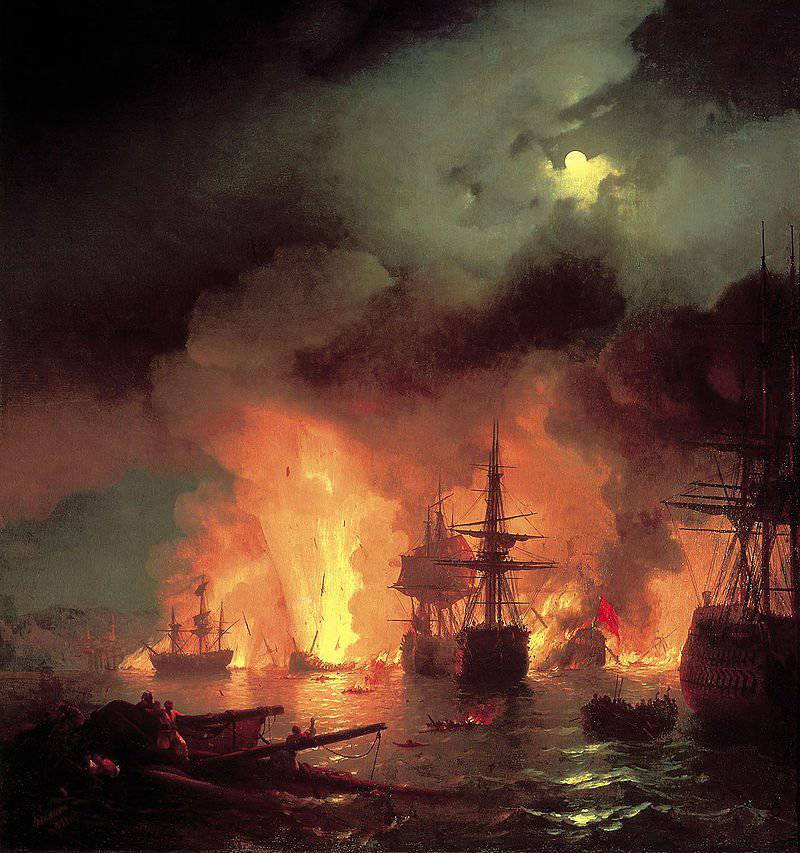
I. Aivazovsky. "Chesme fight"
1771 year. The strategic initiative was completely transferred to the Russian army. In the 1771 campaign, the main role was taken by the 2 Army, whose number was brought to 70 by a thousand people. She was supposed to capture the Crimea. This was facilitated by the fact that the change of the Crimean Khan Porto had prepared discord between the Turks and the Crimean Tatars. In addition, large lesions demoralized the Crimeans. Their allies - wandering between the lower reaches of the Dniester and Buga Bujak and Edisan hordes fell away from Turkey.
1-I army moved to a strategic defense. 35-thousand The army of Rumyantsev needed to protect a huge front along the Danube (500 versts). In February, the Olitz division took over the fortress of Zhurzhu. The Turkish garrison was exterminated - from 10 thousand people killed or sank 8 thousand soldiers. The fortress captured 82 guns. Russian troops lost about 1 thousand people.
Meanwhile, the Ottoman sultan, not wanting to surrender and not losing hope for a break in the war (in this he was supported by the Western powers), formed a new army. The new vizier Musin-Oglu reorganized the army with the help of French military specialists. The army left only regular forces and brought their numbers to 160 thousand people. The Turkish army was concentrated in the Danube fortresses, and since May 1771, began to make raids in Wallachia, trying to push back Russian troops. These attempts continued until late autumn, but were unsuccessful. The Turkish army was unable to realize its numerical advantage.
Moreover, in October, the Ottomans were demoralized by the Weismann raid. Having crossed the Lower Danube, Detachment Weisman brilliantly raided along Dobrudja, seizing all the Turkish fortresses: Tulcea, Isakchu, Babadag and Machin. He brought the Ottomans such fear that the Vizier (who had 25 thousands of troops against 4 thousands of Weismann soldiers) fled to Bazardzhik and expressed readiness to start peace negotiations.
The campaign of the 2 Army under Prince Dolgorukov was crowned with complete success. In June, Perekop was taken, after which the Russian troops occupied Cafu and Gozlev. The Azov flotilla played a major role in this campaign. The Crimean Khanate declared independence from Turkey and passed under the protectorate of Russia. Leaving several garrisons, the Russian army left the Crimean peninsula.
1772-1773 years. Russian successes weapons the Western powers began to be greatly disturbed, they began to put political and diplomatic pressure on Russia. The first section of the Commonwealth in 1772 allowed Russia to resolve differences with Austria and Prussia.
At the front there was a lull. For almost the entire 1772 year and the beginning of the 1773 year in Focsani and Bucharest, peace negotiations with the Ottomans took place. However, the Port did not want to give up the Crimea. France was behind Turkey, which incited the Ottomans not to yield to the Russians, so the war continued.
Empress Catherine demanded decisive action, but Rumyantsev, bound by a lack of strength, limited herself to a number of raids. Weisman made a raid on Karasu and Suvorov made two searches on Turtukai. In June, Rumyantsev tried to attack Silistra (she was defended by the 30-thousand garrison), but when he received the news of the movement of the Turkish army to his rear, he left the Danube. Weisman defeated the Turks at Kaynardzhi, but he himself fell in this battle (5 thousand Russian against 20 thousand Ottomans, five thousand Turks were exterminated). The death of the "Russian Achilles" saddened the whole army. Alexander Suvorov, who was friends with him, wrote: “Weisman was gone, I was left alone ...”.
1774 year. Rumyantsev, despite the shortage of troops and other problems, decided to inflict a decisive blow on the enemy and reach the Balkans. Its 50-th. he divided the army into 4 corps (detachment). The main role had to play the corps of Kamensky and Suvorov on 10 thousand bayonets and sabers. They were given the task of attacking Shumla and smashing the Vizier’s army. Repnin corps was their reserve. The body of Saltykov acted on the Silistra direction. Rumyantsev's corps was a general reserve.
In late April, the troops of Suvorov and Kamensky crossed the Danube and cleared Dobrudja from the Turks. 9 (20) June United Russian corps crushed 40-thousand. army Haji Abdur Rezak. Then the Russian troops blocked Shumla. Rumyantsev forced the Danube, and Saltykov sent to Ruschuk. Russian cavalry moved behind the Balkans, spreading horror and panic everywhere. The Turkish front fell apart again.
The Vizier, seeing the impossibility of further struggle and foreseeing a catastrophe, asked for a truce. But Rumyantsev refused him, saying that he was ready to talk only about the world. Vizier resigned to the will of the great Russian commander.
Petr Aleksandrovich Rumyantsev-Zadunaysky (1725 —1796)
World
10 (21 July) was signed Kyuchuk-Kaynardzhiysky peace treaty. On the Russian side, the contract was signed by Lieutenant-General Prince Nikolai Repnin, on the part of the Ottoman Empire, by the keeper of the sultan's monogram Nitaji-Rasmi-Ahmed and Foreign Minister Ibrahim Myunib. The Crimean Khanate gained independence from the Ottoman Empire. The annexation of Crimea to Russia was now a matter of time. Big and Small Kabarda retreated to the Russian Empire. Russia held Azov, Kerch, Enikale and Kinburn behind, with the steppe adjacent to it between the Dnieper and the Bug.
Russian ships could walk freely in Turkish waters, enjoy the same privileges as French and English ships. Russia gets the right to have its navy on the Black Sea and the right to pass through the Bosphorus and Dardanelles.
Turkey granted amnesty and religious freedom to Balkan Christians. For the Russian Empire recognized the right to protect and protect Christians in the Danube principalities. Amnesty also extended to Georgia and Mingrelia. The port also pledged not to take tribute from the Georgian lands to people (boys and girls) anymore. Russian subjects received the right to visit Jerusalem and other holy places without any payment. Turkey paid a military contribution to 4,5 million rubles.
The treaty became preliminary, as it could not satisfy Turkey, which was eager for revenge, and its Western allies, urging the Ottomans to resume hostilities in order to oust the Russians from the Northern Black Sea region. Almost immediately, the Ottomans began to violate the terms of the peace agreement. The port did not allow Russian ships from the Mediterranean to the Black Sea, conducted subversive work in the Crimea and did not pay a contribution.
And for Russia, the agreement was only the first step in securing the Northern Black Sea region. It was necessary to continue the offensive in order to regain control of the Black (Russian) Sea.
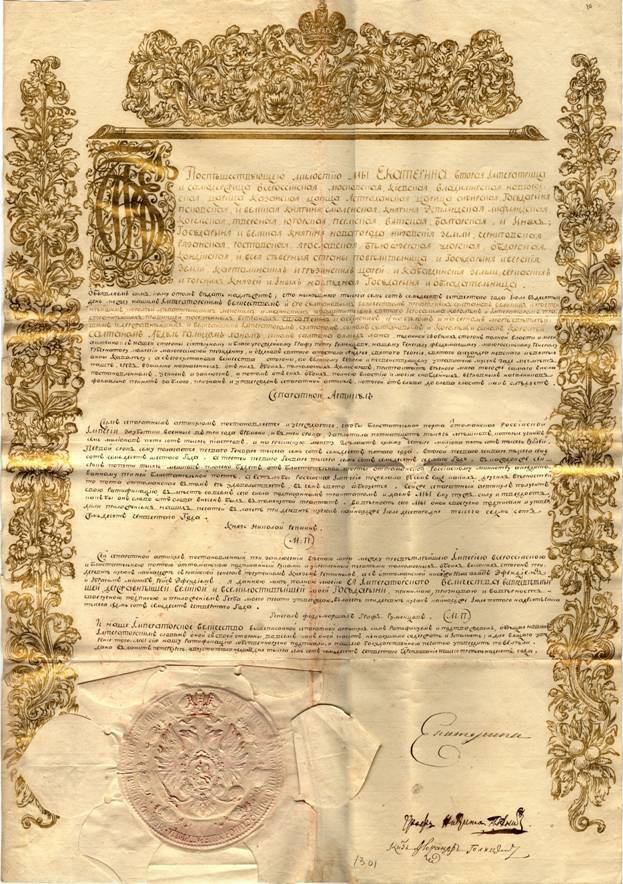
Instrument of ratification to the Kyuchuk-Kaynardzhi peace treaty with the personal signature of Catherine II
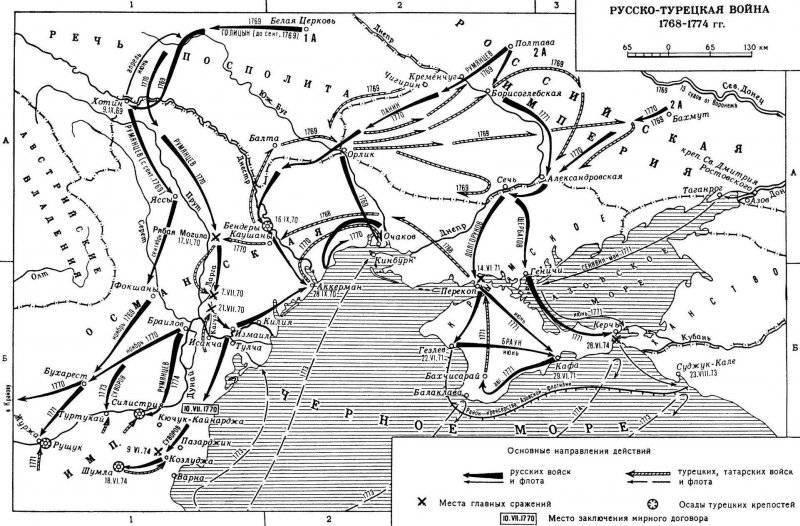
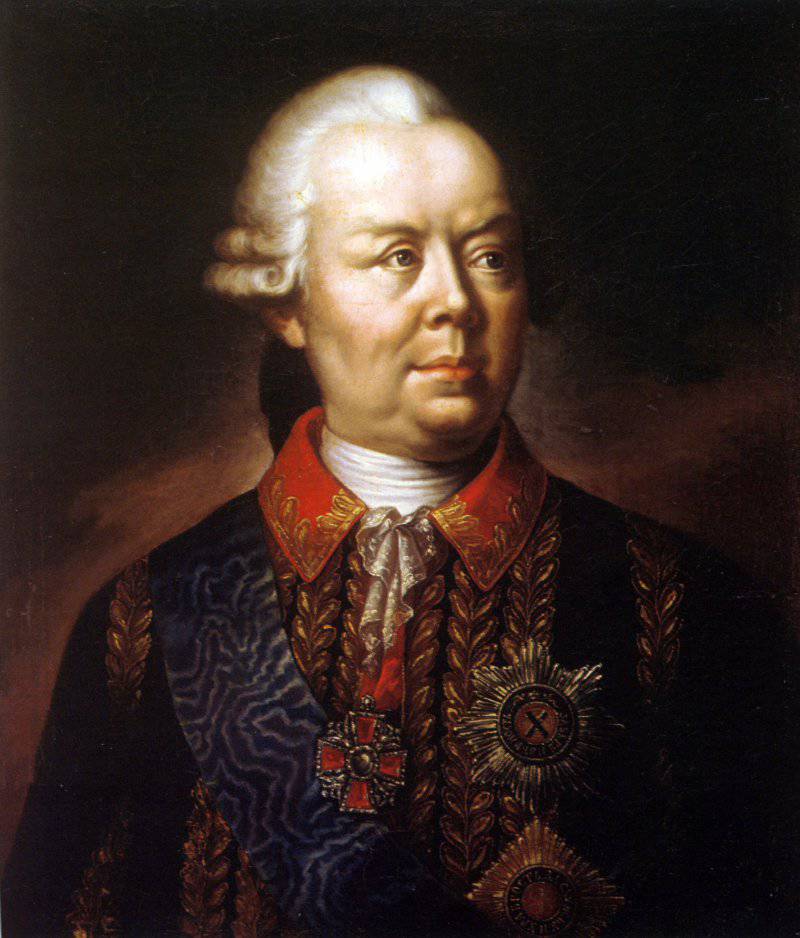
Information